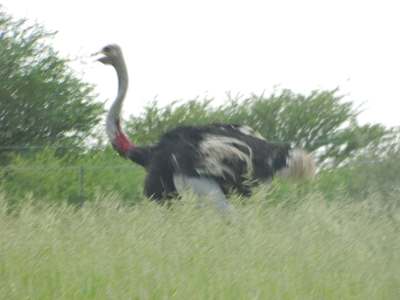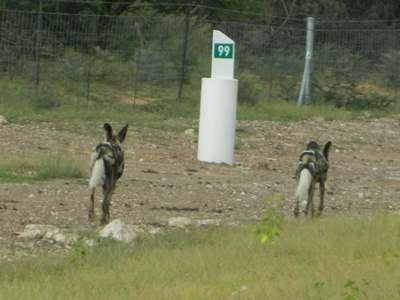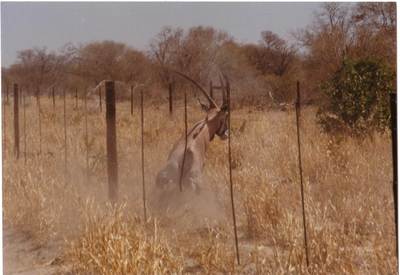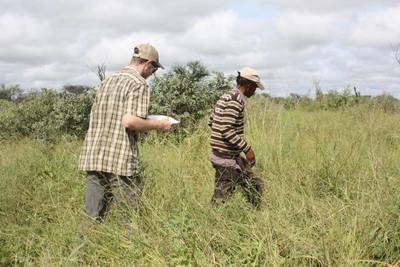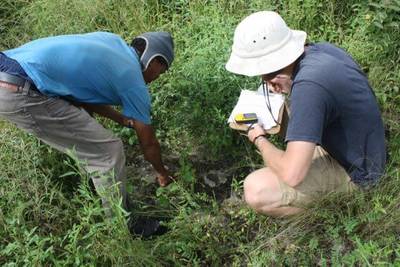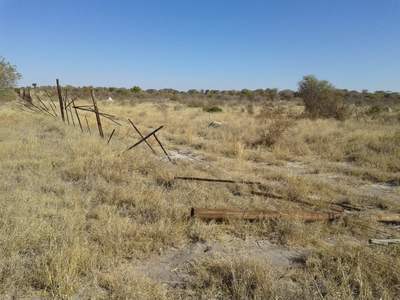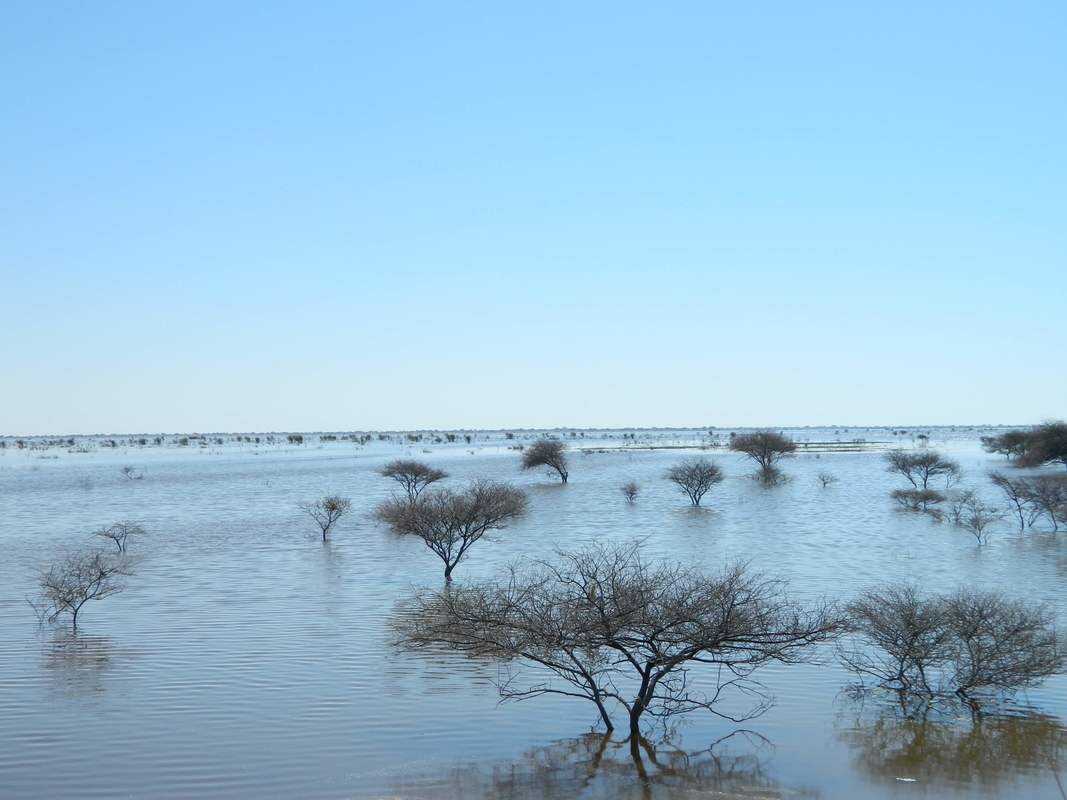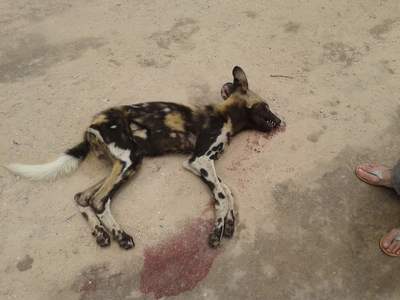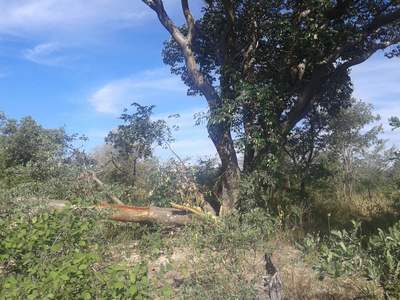Approximately 58% of the Kalahari's relatively unfenced wildlife dispersal areas (WILDLIFE AREA MAPS) are not under formal protection yet their conservation and sustainable use is essential to the functionality and long-term viability of these wildlife ecosystems as a whole.
Protected areas like the Moremi Game Reserve and Chobe National Park in Northern Botswana are not self-sustaining ecological land units and they require connectivity with the much larger surrounding habitat areas to function and remain viable ecologically.
For the sake of the entire ecosytsem and the future of these famous Parks as well, much more needs to be done to halt the steady loss of habitat taking place in the communal lands and wildlife management areas comprising the relatvely unprotected 58%.
The need to address fencing and other habitat fragmentation threats to free-ranging wildlife, and to help communities in those areas to achieve sustainable livelihoods in a way that is compatible with wildlife - is one of the main motivating factors behind the creation of the Kalahari Wildlands Trust.
Protected areas like the Moremi Game Reserve and Chobe National Park in Northern Botswana are not self-sustaining ecological land units and they require connectivity with the much larger surrounding habitat areas to function and remain viable ecologically.
For the sake of the entire ecosytsem and the future of these famous Parks as well, much more needs to be done to halt the steady loss of habitat taking place in the communal lands and wildlife management areas comprising the relatvely unprotected 58%.
The need to address fencing and other habitat fragmentation threats to free-ranging wildlife, and to help communities in those areas to achieve sustainable livelihoods in a way that is compatible with wildlife - is one of the main motivating factors behind the creation of the Kalahari Wildlands Trust.
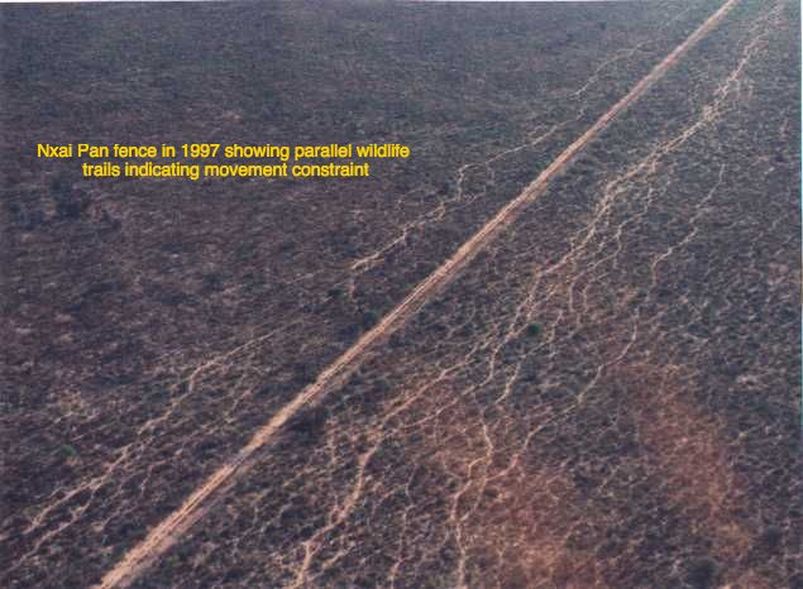
The Nxai Pan Buffalo Fence was removed by the Botswana Government in 2004, allowing the restoration of historical migration routes of zebra, wildebeest and elephant between the Okavango-Linyanti and the Makgadikgadi Pans: The further recovery of wildlife biomass along the Boteti River (Western boundary Makgadikgadi Pans N.P.) is vital to achieving its economic potential as a community tourism development area.
Addressing fencing and livestock development threats to the wildlife dispersal areas:
Arthur's mostly voluntary efforts in drawing attention to the impact of veterinary fences on wildlife started in 1996. His persistent monitoring, reporting and lobbying were instrumental to the Botswana Government's fast-tracking of a retroactive EIA study on new fences in 1999, and in the removal of the 68km Nxai Pan Buffalo Fence in 2004, as well as sections of the Setata Fence (NG5) totaling 190km in 1998, 2004 and 2008: These commendable but unpublicized decisions, spearheaded by His Excellency, The Former President of Botswana, Lt.Gen. S.K.I.Khama, put an end to ongoing stress on wildlife in the affected areas and enabled the recovery of some important migration routes.
However, more still needs to be done to address the ongoing impact of some existing, unmaintained fences that cut into largely cattle-free wildlife habitats. Furthermore, new development threats have emerged in the form of new veterinary fence and fenced ranching development plans, spearheaded by the Department of Veterinary Services and the Department of Lands respectively.
The KWT is striving to continue this conservation work by scientifically assessing wildlife habitats in those parts of the wildlife dispersal areas that are most affected by these existing and proposed fencing developments (see Map 3 in WILDLIFE AREA MAPS ).
In its capacity as an interested party in the current Environmental Impact Assessment (EIA) study for the proposed new 68km fence along the Eastern boundary of Wildlife Management Area NG5, KWT commissioned detailed spoor surveys to assess wildlife presence and movement patterns along the remaining portion of the now dilapidated Setata fence along the Eastern NG5 boundary (the same proposed alignment of the new fence) as well as parts of the proposed fenced ranching area in Southern NG5.
These surveys were coordinated by KWT, as assisted by Round River Conservation Studies and Wildlife ACT, in February and June 2017 respectively. The data results show that the proposed fence - as with previous fencing developments in the area - is likely to induce stress, injury and mortality on wildlife, in particular species already in decline such as wildebeest, eland and zebra. The presence of 7 IUCN Red Listed mammal species were also confirmed within and adjacent to the proposed ranching area in NG5, which - if it goes ahead as planned - is likely to result in permanent loss of habitat, loss of animals contained within the ranching area, and impacts on wildlife populations in adjacent areas attempting to move through the area following their natural dispersal patterns.
In addition to providing stakeholders and decision-makers with thorough, scientifically based data on the environmental sensitivities related to existing and proposed fencing developments, the KWT will continue lobbying for the mitigation or avoidance of impacts through the creation of strategically placed gaps, or complete fence removals, where justifiable.
An estimated 1000km of veterinary fences in Northwest District alone, are in a state of disrepair and in some instances causing ongoing stress, injury and mortality to wildlife. Whilst it is true that some fences are beneficial in separating land usage in areas where large numbers of livestock interface with wildlife, the fences of greatest concern to KWT typically bisect areas with no or very low cattle densities, where no practical purpose is achieved by having a fence. The KWT accordingly advocates for the removal of such fences to help limit further stresses on wildlife and promote population recovery, in particular for those species already in decline outside of the Parks, such as zebra, hartebeest, springbok, eland and wildebeest. Fence removal is also critical to reducing human-elephant conflict by facilitating elephant expansion into alternative habitats with lower human population densities.
The KWT also advocates for the exploration of alternatives to linear veterinary fencing within Foot and Mouth Disease (FMD) infected zones such as Northwest District (Ngamiland), to supplement existing livestock vaccination programs. Of particular interest is the potential for the creation of fenced quarantine camps for effecting disease control in all cattle intended for export sale, as a standard procedure. Such relatively low impact potential alternatives are in line with the Commodity Based Trade (CBT) approaches now endorsed by the OIE (World Organization for Animal Health) and have the potential to result in cost savings to the benefit of the Department of Veterinary Services. The work of the USAID-sponsored AHEAD working groups is particularly noteworthy as it confirms that non-fencing alternatives do exist and that they can be legally implemented within the FMD zones, with the full blessing and support of the OIE.
Also of concern is the need to urgently reconsider proposals by the Department of Lands for dezoning over 1 million hectares of wildlife management areas (e.g. portions of NG5, GH10, GH11, SO2, KW6) into livestock development areas and private fenced cattle ranches: These proposals were developed in 2009 in the absence of any EIA or Strategic Environmental Assessment (SEA) studies, and were based, inter-alia, on a subjective assessment of unreliable aerial census data applicable to only a short time period. By contrast, independent spoor based surveys of the affected areas carried out by Derek Keeping (see PDF file below), in addition to analyses of longer-term aerial census data, clearly show that the areas proposed for dezoning still provide important habitat for IUCN red listed species and that they still function as important movement corridors.
The ranching plans therefore are likely to result in loss of significant numbers of IUCN Red Listed species, and the severe constriction of wildlife dispersal and migration corridors linking the Central Kalahari Game Reserve (CKGR) with the Kgalagadi Transfronteir Park. Hundreds of wild animals are also likely to be subjected to fence-related stress, injury and mortality. Accelerated decline in populations of wildlife outside of the protected areas, as well as some populations moving to and from the protected areas is likely to be the end result. These ranching developments will also have far reaching implications for some local communities hoping to derive much needed income through sustainable use of their wildlife resources.
| realistic_population_estimates_of_wildlife_species_inhabiting_so2-kw6_wmas_final.pdf | |
| File Size: | 1702 kb |
| File Type: | |
Wildlife habitat recovery and the creation of new spatial linkages:
The protection of wild herbivore access to large salt pans, mineralized soils, water sources and palatable grazing, is vital to their survival and ability to rapidly and successfully produce offspring during favourable rainfall seasons. The provision of boreholes within the protected areas such as the CKGR, as a mitigation strategy for loss of access to historical migratory range outside the Reserve, has not succeeded in reversing the ongoing progressive decline in population numbers of hartebeest, springbok and wildebeest (currently at less than 5% of estimated numbers in the late 1970's). This is because access to large pans, mineralised soils and preferred palatable grazing, is a more important requirement than surface water for these arid-adapted species, and some of these resources are in abundance only in specific areas outside of the CKGR.
In order for Botswana to realize the full economic potential of its tourism industry and grow its Community Based Resource Management Programmes to the benefit of local communities, it is imperative to maintain and rehabilitate the three key attributes or 'Unique Selling Points' on which this all depends: wilderness, culture and wildlife.
Botswana possesses one of Earth's largest remaining tracts of untransformed wilderness and this is the Country's most unique, globally significant asset. Although the wildlife biomass has been depleted through the effects of habitat loss and fencing, vast tracts of viable natural habitat still remain and the Kalahari has not yet lost its wildlife biomass production potential. Botswana's low human population places it in the unique position of being capable of dramatically restoring its wildlife biomass much closer towards historical levels, through creative planning (e.g. realignment of fences) and support for CBNRM initiatives.
Based on the sheer size of the available habitat, the potential therefore exists for the creation of Africa's single largest biomass of migratory wildlife. If this could be created, Botswana would become the world's primary destination for wildlife based tourism - and the contribution of its tourism industry to revenue generation and citizen employment would likely far exceed the current projections.
We have identified several opportunities for the restoration of connectivity that would facilitate the required wildlife population recovery:
1. The realignment of the current, already-dilapidated, border fence between Namibia and Botswana to incorporate Kaudum National Park, and potentially some of the Namibian conservancies to the South, in order to expand the Northern wildlife dispersal area by up to 20% (31,400 sq,km) to 185,849 sq.km. This would reestablish wildlife connectivity between the Okavango Delta and important resource areas historically functioning as summer wildlife calving areas such as the Nyae-nyae pans, and dramatically improve wildlife population abundance and resilience on both sides of the border, creating expanded and more economically-viable wildlife tourism development opportunities for both countries and incentivizing a much needed shift towards alternatives to farming in populated areas along the western periphery of the Okavango Delta.
2. The realignment of the Eastern CKGR boundary fence to reconnect the CKGR with the Boteti River, Lake Xau and associated pans and paleo-lake grazing areas. This will enable remnant wildebeest and other wildlife trapped outside the CKGR to reconnect with the CKGR widllife biomass and resume seasonal east-west shifts to and from the pans and mineral rich grazing lands located closer to Lake Xau. This has the potential to accelerate breeding rates leading to largescale biomass recovery in wildebeest, hartebeest and springbok populations and the creation of multiple commercial tourism opportunities for population centres at Kedia and Mopipi, as well as for the owners of underutilized ranches in the corridor to be created. The potential also exists for relinking the Northern and Southern dispersal areas via a fenced corridor across the Boteti River, creating similar immense opportunity for wildlife recovery and re-establishment of historical migration routes.
3. The development of wildlife tourism enterpises at key pans in Southern GH11 in partnership with local communities and farmers, to incentivise the lowering of cattle stocking rates and poaching levels in historical wildlife breeding localities.
The KWT is seeking strategic partnerships and funding support to coordinate feasibility studies on these potential interventions, mobilize local communities and landholders, and initiate pilot tourism projects with the support of Government and the private sector.
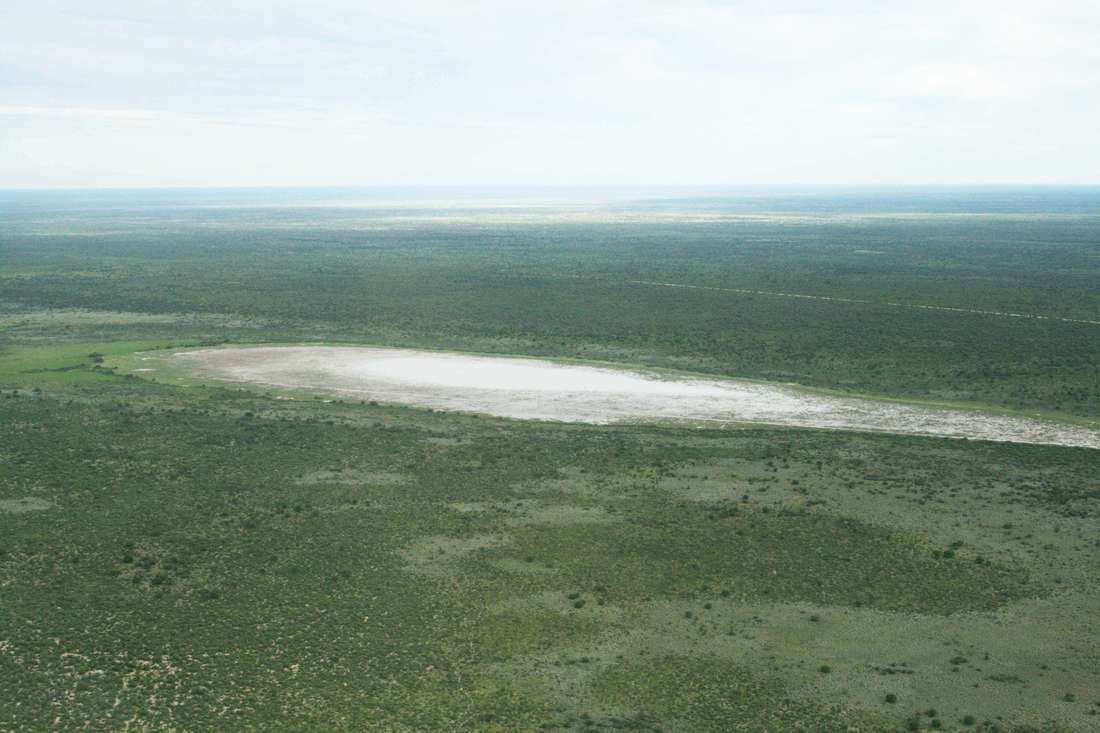
The minerals from large pans like this one in NG5 help wild herbivores to maintain the gut microflora that enable them to digest the coarse grasses they eat, and the ingested minerals assist in healthy uterine development in pregnant females. Pans also provide spatial protection from predators during calving seasons. By comparison, artificial water points may become bush-encroached and under-utilised by herbivores due to their predator ambush potential.
Human-wildlife conflict mitigation:
In its existing community wildife conservancy project area in NG3 (Western Ngamiland), the KWT is assisting a target community to protect its borehole installation, campsite and 'Mongongo' trees (Schinziophyton rautanenii) with chilli-powder elephant deterrents. The expansion of elephant ranges has impacted significantly in NG3 on Mongongo trees, a staple food (edible nut) for many Ju/hoansi San and has caused frequent damage to boreholes and water tanks, especially in the dry season when the only available water sources are at human occupied sites.
As a longer term solution, KWT is seeking funds to develop a wildlife borehole in a more remote northerly part of the project area surrounded by less sensitive vegetation types: This measure will assist in reducing the incidence of hazardous human-elephant contact and will reduce foraging pressure on the sensitive Mongongo woodlands. During the recent drought years, the movement of wildlife from remote northerly areas southwards along the border fenceline into the populated valley areas where settlements such as Qangwa are located, placed these animals at risk of harmful interaction with humans. It is likely therefore that other wildlife species will also benefit by having accesss to a reliable dry season water supply in relatively remote, undisturbed areas.
The KWT is seeking urgent financial support to develop and monitor the proposed wildlife borehole.
